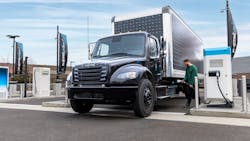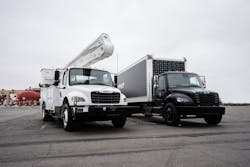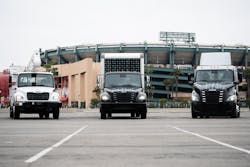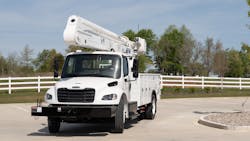DTNA reveals production-ready Freightliner eM2
ANAHEIM, California—Daimler Truck North America is on a mission to offer CO2-neutral vehicles by 2039.
Five years into the OEM’s decarbonization journey, the truck manufacturer rolled out its fourth battery-electric model for the North American market here at the 2023 Advanced Clean Transportation Expo.
Built on the M2 106 Plus platform and introduced on the heels of the series production Freightliner eCascadia Class 8 tractor, DTNA’s Freightliner division has unveiled the series production eM2 for pickup-and-delivery applications.
See also: ATA’s Spear calls out 'unrealistic' trucking emissions timelines
“We felt that as we were developing our e-mobility effort for the medium-duty space that it was important to have that level of familiarization and that smooth transition for our customers,” explained Greg Treinen, director of on-highway market development at DTNA, adding that the M2 106 Plus platform has been DTNA’s medium-duty workhorse for the past two decades. “The eM2 has a lot of the same benefits that our customers experience today with the M2 106 Plus, including the visibility, turning radius, ingress, egress, and all those features.”
The new eM2, available in Class 6 and Class 7 configurations, is ready to order and will start production this fall at DTNA’s Portland, Oregon, truck manufacturing plant. At the same time, Freightliner announced it will expand the eM2 medium-duty truck for vocational applications, with utility and sweeper applications among the first vocational offerings.
"With its versatility, the eM2 will be the perfect fit for pickup-and-delivery customers who require an adaptable electric solution,” noted David Carson, DTNA’s SVP of sales and marketing. “Our vocational innovation vehicles are designed to set the stage to expand eM2 coverage into additional customer applications in the future."
Powertrain options
Utilizing DTNA’s production experience and 1.5 million real-world miles, the eM2 on-highway vehicle is tailored for pickup-and-delivery, beverage hauling, local, regional, and city routes, explained said Rakesh Aneja, VP and chief of eMobility at DTNA.
The Class 6 single-motor configuration provides up to 190 continuous horsepower, a 194 kWh battery, and a typical range of 180 miles on one charge. The Class 7 dual-motor configuration provides up to 255 continuous hp, a 291 kWh battery, and a typical range of 250 miles on a single charge.
The eM2 features a fully integrated, battery-electric Detroit ePowertrain, including Detroit eAxles and batteries. The vehicle minimizes energy cost per mile by removing the drivetrain and other mechanical components in favor of a lighter, simpler design, which packages the electric motors and two-speed transmission directly onto the drive axles.
In addition to electrification, Aneja pointed out during a media ride-and-drive event just before the start of ACT Expo that DTNA is strongly looking at hydrogen-powered vehicles as part of the industry’s efforts to decarbonize.
“We believe both are going to be required, and it’s really battery-electric and hydrogen-powered vehicles that can be truly CO2 neutral and provide the long-term result for us,” he said.
Efficiency, safety, connectivity
At first glance, it's easy to discern some fundamental eM2 design differences compared to the M2 106 Plus platform.
“First, you’ll notice we have a new hood and a new grill,” explained Katie Rabideau, DTNA’s eMobility product marketing manager. “These are designed for efficiency and aerodynamics, but also designed from a styling perspective to signal the eM2 as part of the eCascadia product portfolio.”
See also: Daimler enters medium-duty EV race with Rizon brand
Externally, the new truck is enhanced with battery side impact protection, and the vehicle comes standard with the Detroit Assurance suite of safety systems:
- Active brake assist 5.0
- Tailgate warning
- Adaptive cruise control to 0 mph
- Lane-departure warning
- Intelligent high beams
- Automatic wipers/headlamps
- Side guard assist
The eM2 also comes equipped with an ergonomic wrap-around dash that has been designed with the driver in mind, Rabideau explained. The truck features a two-screen LCD display with an A-panel that is fully customizable for the driver and showcases information about the electric powertrain. The B-panel includes a touch-screen display that includes infotainment, navigation, preconditioning information, and scheduling for vehicle charging.
Equipped with connected vehicle offerings, Detroit Connect, which offers new eServices and provides charging information and vehicle health data in real time, the eM2 allows fleet managers to:
- Plan new routes with real-time range prediction, updating automatically for traffic, weather, topography, and other conditions.
- Monitor battery health and state-of-charge for multiple units in real-time.
- Collect data for post-trip analysis reports, which can help coach drivers to maximize energy efficiency and battery lifespan.
Testing, market availability
The eM2 underwent extensive summer and winter testing as well as rough-road and crash tests to be able to operate under various conditions and temperatures, according to DTNA.
Along with the eCascadia, the eM2 accumulated more than 1.5 million test miles in customer innovation and experience fleets driven in a variety or real-world applications in almost 50 real fleets operating across the West Coast, New Jersey, and Canada.
Continuing its effort to gain real-world experiences, DTNA will begin running an eM2 vocational innovation program with leaders in the truck equipment manufacturing industry and their customers to focus on providing zero-emission solutions for the unique requirements of vocational customers and applications. This program particularly targets the utility, sweeper, dump, towing and recovery, and refuse segments and will be packaged and designed for maximum frame space utilization with minimal impact on upfit, especially in the utility segment.
The goal with the eM2 vocational innovation program is to offer operators the familiarity and experience of the M2 chassis while allowing for consistency and ease in the transition to battery-electric operations.
The eM2 vocational innovation vehicles are validating new target specifications with work-truck customers in the real world (actual production vehicle specifications are subject to ongoing tests):
- Up to 330 kWh of usable battery capacity
- Target of 150 miles range, depending on the application
- Wheelbases between 155-inch and 220-inch
- Only 10-inch of back-of-cab protrusion space for battery
- Both electric and mechanical ePTO options to support hydraulic and battery-powered body equipment using the vehicle’s high-voltage battery
Preparing fleets for EVs
After working with Freightliner customers over the last several years to transition their commercial trucking fleets to electric, a team of Detroit eConsultants are on-hand to help fleets right-size infrastructure, choose ideal chargers, navigate rebates and incentives, assist with site selection, optimize routes, provide connectivity insights, and offer photovoltaic and energy storage options. They also introduce customers to the comprehensive line of Detroit eFill Chargers, evaluate duty cycles, and help identify ways to put eM2 trucks to work.
See also: 2023 alternative fuel engine outlook
“This is a transformation of the entire energy industry,” Aneja said. “We are trying to upend a single source of energy that we’ve used for 100 years, and we just don’t want to hand an electric truck or hydrogen-powered truck to our customers and say, ‘Here you go, have a nice day, the rest is up to you.’ We want to support them in every step of the ecosystem and every step of the journey because this is a new topic for all of us.”
That's why Detroit’s Charger Management System (CMS) provides fleet managers with the insights to understand their fleets’ energy consumption patterns and create a charging schedule that reduces cost per mile.
In addition, more than 90% of Freightliner’s dealer network in North America has completed an EV Masters Sales training course, and dealers are fully equipped to answer EV questions and evaluate the best use cases for eCascadia and eM2 applications as well as identify potentially relevant EV rebates in a specialized database, DTNA noted.
Further, more than 1,400 dealership technicians are trained today in high-voltage safety as dealers are preparing to service eCascadia and eM2.
When it comes to funding, Daimler Truck Financial offers a full suite of financing products specifically tailored to both vehicles and charging infrastructure, including lease and retail loan options, customer revolving lines of credit, floorplan financing, and construction and real estate loans. The lease structure allows for a decrease in the initial upfront investment, making electric vehicles more accessible for fleets of all sizes and helps to control costs moving in to electric with predictable payments and the usual lease-related backend risk terms and conditions.
“Leasing is a pretty big part of the industry today,” DTNA’s President and CEO John O’Leary said during a media roundtable discussion at ACT Expo. “On the battery-electric side people are trying to mitigate their risk, so leasing is a way around that."
“Nobody has all the answers,” O’Leary added. “We are going through this huge transformation. For us, we are just trying to bring everyone together and understand the questions, who has the answers, and how we can be flexible and nimble.”
This article was originally published on FleetOwner.com.
About the Author

Cristina Commendatore
Cristina Commendatore is the Executive Editor of FleetOwner magazine. She has reported on the transportation industry since 2015, covering topics such as business operational challenges, driver and technician shortages, truck safety, and new vehicle technologies. She holds a master’s degree in journalism from Quinnipiac University in Hamden, Connecticut.






